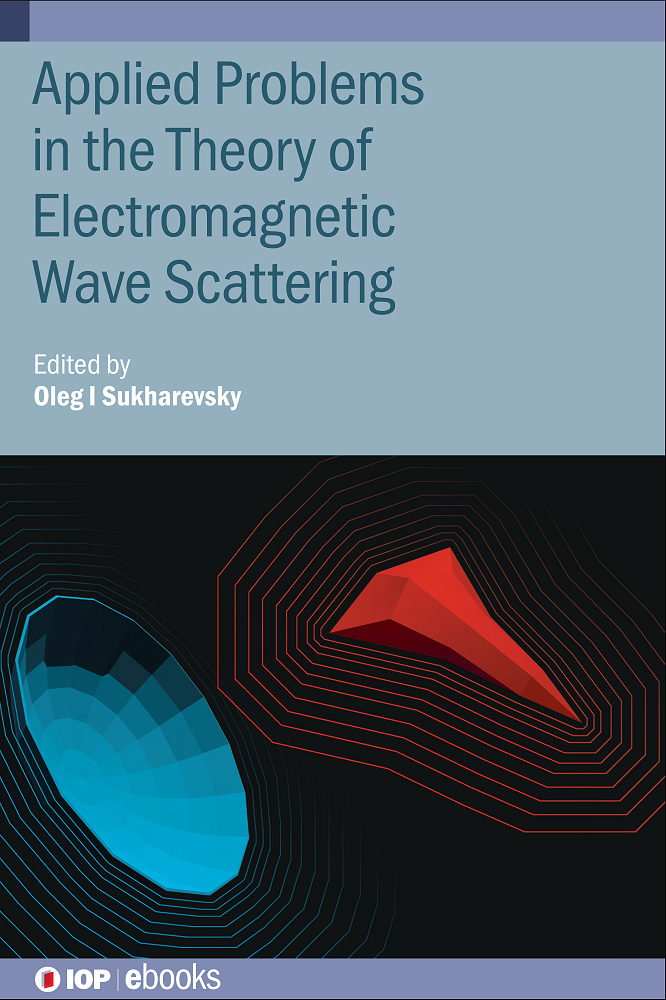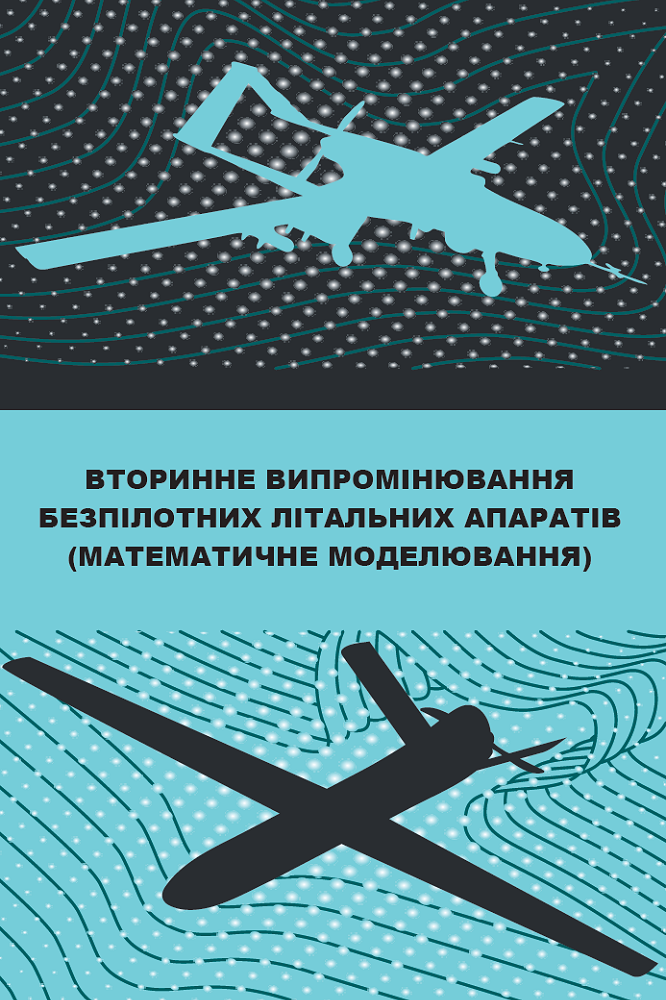
Electromagnetic Scattering Group
&
Professor Oleg I. Sukharevsky
present
the series of books with open access
(almost all books)

Applied Problems in the Theory of Electromagnetic Wave Scattering
Edited by professor O. Sukharevsky
Authors: Sergey V. Nechitaylo, Valery M. Orlenko, Oleg I. Sukharevsky, Vitaliy A. Vasilets, Gennady S. Zalevsky
Year: 2022
To buy this book go to IOP Publishing site.
To get additional information and download some book parts go to IOPscience site.
Electromagnetic wave scattering is the reradiation of electromagnetic energy which occurs when an electromagnetic field encounters an abrupt change in electrical or magnetic properties. This occurs when an electromagnetic field is incident on a structure or scattering object. When the original electromagnetic field crosses the boundary between two regions, each with different electrical or magnetic parameters, the field will change as it enters the second region. This abruptly changing propagation medium induces sources of scattering at the boundary between the two media, including conduction and displacement currents.
This book explores the development of electromagnetic theory in the field of scattering. Solutions to applied problems of electromagnetic wave scattering are presented and include resonant electromagnetic wave scattering, solved by the integral equation method, and 2D and 3D scattering problems, solved by the asymptotical (short wave) method. The book provides worked examples throughout for analysis of the electromagnetic wave scattering processes by different objects.
Demonstrations on how to obtain practically important estimates of scattering characteristics of objects are included. The book also includes tools to design new variants of the objects and entities are also provided.
The key audience for this book includes researchers in the field of electromagnetic scattering and designers of radar and radio equipment.
Key Features:
- Presents solutions to several applied problems of electromagnetic wave scattering by the integral equation method and asymptotical (short wave) method.
- Includes the development of electromagnetic theory in the field of scattering for a wide range of objects of different nature.
- Uses worked examples for the analysis of electromagnetic wave scattering processes by different objects.
- Discusses how to obtain practically important estimates of scattering characteristics of objects.
- Contains tools to design new variants of the objects and entities.
Contents
Preface from editor
Introduction
1 Using an integral equation method for solving problems of resonant electromagnetic wave scattering
1.1 Electromagnetic wave scattering at resonant size impedance screens of finite thickness
1.1.1 Derivation of integral equation systems
1.1.2 Method for solving the obtained integral equations
1.1.3 Electromagnetic wave scattering at a non-perfectly conducting screen of finite thickness
1.1.4 Computation of fields radiated by a dual-reflector antenna, taking into account the interaction of the two reflectors
1.2 Magnetic field integral equation for solving problems of resonant electromagnetic wave scattering by perfectly conducting objects
1.2.1 Deriving the magnetic field integral equation
1.2.2 Numerical solution to the obtained integral equation
1.3 The Mėller integral equation set for solving problems of resonant electromagnetic wave scattering by dielectric homogeneous objects
1.3.1 Deriving the Mėller integral equation set
1.3.2 Algorithm for finding a numerical solution to the Mueller integral equation set
1.4 Using an integral equation method for numerical modeling of electromagnetic scattering by metallic, dielectric, and combined resonant objects in applied problems
1.4.1 Radar scattering characteristics of an unmanned aerial vehicle in the VHF and S frequency bands
1.4.2 The high-resolution radar range profiles of artillery shells
1.4.3 The radar detection and identification of metallic and dielectric mines buried in the ground
1.4.4 Electromagnetic wave scattering by meteorological particles of various shapes
1.4.5 Electromagnetic scattering and radiation characteristics of an antenna inside a dielectric radome of resonant size
1.4.6 Electromagnetic wave scattering by nanoparticles in the optical band
2 Asymptotic methods for solving some applied problems
2.1 Electromagnetic wave scattering by a cylindrical object immersed in a dielectric half-space
2.1.1 Calculation method for a perfectly conducting object
2.1.2 Calculation features for an impedance object
2.1.3 The possibility of figuring out the parameters of the scattering cylinder
2.2 Reconstruction of the 'illuminated' surface part of a convex perfectly conducting scatterer
2.2.1 Finding the principle curvatures at the point of specular reflection
2.2.2 The algorithm for reconstructing the 'illuminated' part of the object's surface
2.2.3 Results of numerical simulation
2.3 Scattering and radiation characteristics of antenna systems under nose dielectric radomes
2.3.1 Electromagnetic wave scattering by an antenna system under the nose dielectric radome
2.3.2 Radiation of an antenna system under a nose dielectric radome
2.4 The influence of precipitation on the gain of the reflector antennas
2.4.1 A method for computing the fields radiated by reflector antennas that are partially covered by precipitation layers
2.4.2 Numerical simulation of the radiation characteristics of reflector antennas that are partially covered with snow
2.4.3 Numerical simulation of the reflector antenna radiation performance given a non-symmetrical distribution of precipitation deposit over its reflector's surface
2.4.4 Verification of the proposed method for predicting the radiation performance of reflector antennas whose surface was partially covered by precipitation
2.5 Near-field calculation for an electrically large reflector antenna
2.5.1 The method for computing the field radiated by a reflector antenna in the near-field zone
2.5.2 Near-field computation results
2.6 Electromagnetic wave scattering by thin wires placed inside dielectric shells
2.6.1 Scattering of an electromagnetic wave by a thin wire housed inside a thin dielectric shell
2.6.2 Verification of the method and the results of computation
2.7 Backscattering of an inflatable dielectric lifting-turning device designed for ground measurement of radar object scattering characteristics
2.7.1 Method for computing the radar cross section of a thin dielectric shell of large electric sizes
2.7.2 Computation of the radar cross section for the inflatable lifting-turning device
2.7.3 Possible measures for reducing parasitic scattering from lifting-turning device
2.8 A computation method for electromagnetic wave scattering by dielectric toroid formations
2.8.1 Introduction to electromagnetic scattering by meteorological formations
2.8.2 A method for computing the electromagnetic waves scattering by dielectric torus
2.8.3 Results of simulating the radar cross section of the dielectric torus
2.9 A method for camouflaging ground vehicles to prevent their detection by radar
2.9.1 Basic relations for the radar cross section of ground objects
2.9.2 Results of computer simulation
If you need more information, please contact us via email info@radar.dinos.net.



